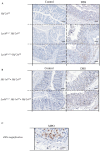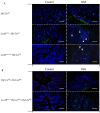The Importance of Hypoxia-Inducible Factors (HIF-1 and HIF-2) for the Pathophysiology of Inflammatory Bowel Disease
- PMID: 33202783
- PMCID: PMC7697655
- DOI: 10.3390/ijms21228551
The Importance of Hypoxia-Inducible Factors (HIF-1 and HIF-2) for the Pathophysiology of Inflammatory Bowel Disease
Abstract
(1) Background: Hypoxia is a common feature of inflammation when hypoxia inducible factors (HIFs) adapt cells to conditions of low oxygen tension and inflammation. We studied the role of HIF-1 and HIF-2 in cells of the myeloid lineage in a mouse model of acute colitis. (2) Methods: Mice with and without a conditional knockout for either Hif-1a or Hif-2a or Hif-1a and Hif-2a in cells of the myeloid lineage were treated with 2.5% dextran sodium sulfate (DSS) for 6 days to induce an acute colitis. We analyzed the course of inflammation with respect to macroscopic (disease activity index) and microscopic (histology score and immunohistochemical staining of immune cells) parameters and quantified the mRNA expression of cytokines and chemokines in the colon and the mesenteric lymph nodes. (3) Results: A conditional knockout of myeloid Hif-1a ameliorated whereas the knockout of Hif-2a aggravated murine DSS colitis by increased recruitment of neutrophils to deeper layers of the colon. This led to higher expression of Il6, Ifng, Cd11c, Cd4, and Cd8 in the colon but also induced anti-inflammatory mediators such as Foxp3 and Il10. A conditional knockout of Hif-1a and Hif-2a did not show any differences compared to wildtype mice. (4) Conclusions: Myeloid HIF-1α and HIF-2α play opposing roles in acute DSS colitis. Thus, not only a cell type specific, but also the isoform specific modulation of HIFs needs to be addressed in attempts to modify HIF for therapeutic purposes.
Keywords: HIF-1; HIF-2; IBD; inflammation.
Conflict of interest statement
The authors declare no conflict of interest.
Figures















Similar articles
-
HIF-1α activation in myeloid cells accelerates dextran sodium sulfate-induced colitis progression in mice.Dis Model Mech. 2018 Jul 30;11(7):dmm033241. doi: 10.1242/dmm.033241. Dis Model Mech. 2018. PMID: 29967068 Free PMC article.
-
Hypoxia-inducible factor 1 in dendritic cells is crucial for the activation of protective regulatory T cells in murine colitis.Mucosal Immunol. 2016 Mar;9(2):379-90. doi: 10.1038/mi.2015.67. Epub 2015 Jul 29. Mucosal Immunol. 2016. PMID: 26220168
-
Endothelial PAS domain protein 1 activates the inflammatory response in the intestinal epithelium to promote colitis in mice.Gastroenterology. 2013 Oct;145(4):831-41. doi: 10.1053/j.gastro.2013.07.010. Epub 2013 Jul 13. Gastroenterology. 2013. PMID: 23860500 Free PMC article.
-
Oxygen Sensing in Innate Immune Cells: How Inflammation Broadens Classical Hypoxia-Inducible Factor Regulation in Myeloid Cells.Antioxid Redox Signal. 2022 Nov;37(13-15):956-971. doi: 10.1089/ars.2022.0004. Epub 2022 Jul 27. Antioxid Redox Signal. 2022. PMID: 35088604 Review.
-
Oxygen sensing in intestinal mucosal inflammation.Pflugers Arch. 2016 Jan;468(1):77-84. doi: 10.1007/s00424-015-1722-4. Epub 2015 Jul 25. Pflugers Arch. 2016. PMID: 26206140 Review.
Cited by
-
Interrelation of Hypoxia-Inducible Factor-1 Alpha (HIF-1 α) and the Ratio between the Mean Corpuscular Volume/Lymphocytes (MCVL) and the Cumulative Inflammatory Index (IIC) in Ulcerative Colitis.Biomedicines. 2023 Nov 24;11(12):3137. doi: 10.3390/biomedicines11123137. Biomedicines. 2023. PMID: 38137357 Free PMC article.
-
Synergistic rheumatoid arthritis therapy by interrupting the detrimental feedback loop to orchestrate hypoxia M1 macrophage polarization using an enzyme-catalyzed nanoplatform.Bioact Mater. 2024 Jul 23;41:221-238. doi: 10.1016/j.bioactmat.2024.07.026. eCollection 2024 Nov. Bioact Mater. 2024. PMID: 39149592 Free PMC article.
-
Crosstalk between Heme Oxygenase-1 and Iron Metabolism in Macrophages: Implications for the Modulation of Inflammation and Immunity.Antioxidants (Basel). 2022 Apr 27;11(5):861. doi: 10.3390/antiox11050861. Antioxidants (Basel). 2022. PMID: 35624725 Free PMC article. Review.
-
The mechanism of colon tissue damage mediated by HIF-1α/NF-κB/STAT1 in high-altitude environment.Front Physiol. 2022 Sep 9;13:933659. doi: 10.3389/fphys.2022.933659. eCollection 2022. Front Physiol. 2022. PMID: 36164339 Free PMC article.
-
Hypoxia, hypoxia-inducible factors and inflammatory bowel diseases.Gastroenterol Rep (Oxf). 2024 Apr 17;12:goae030. doi: 10.1093/gastro/goae030. eCollection 2024. Gastroenterol Rep (Oxf). 2024. PMID: 38638288 Free PMC article. Review.
References
-
- Alatab S., Sepanlou S.G., Ikuta K., Vahedi H., Bisignano C., Safiri S., Sadeghi A., Nixon M.R., Abdoli A., Abolhassani H., et al. The global, regional, and national burden of inflammatory bowel disease in 195 countries and territories, 1990–2017: A systematic analysis for the Global Burden of Disease Study 2017. Lancet Gastroenterol. Hepatol. 2020;5:17–30. doi: 10.1016/S2468-1253(19)30333-4. - DOI - PMC - PubMed
MeSH terms
Substances
LinkOut - more resources
Full Text Sources
Molecular Biology Databases
Research Materials

